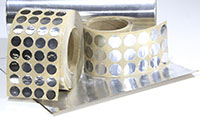Auto-leveling sensors (Induction Sensors) have become one of the most desired 3D Printer Modifications. These new sensors accelerate prep time limiting countless adjustments to springs and screws on the print bed. Using a sensor helps obtain more accurate calibrations creating a more level bed, limiting the possibilities of prints coming undone on one or corner or nozzle jams from incorrect nozzle height.
However upgrading the sensor limits the type of surface material you can use on the print plate. Induction sensors (using electro magnetism) use aluminum to detect the build plate. Through our research we have found that PEI is the top of the charts as a build surface. However PEI can not be used with a induction sensor without using a metalized material (aluminum) underneath. Here at CS Hyde we wanted to provide a cost effective solution to the PEI/Sensor issue. Our aluminum foil sheets backed with high temp adhesive allow users to securely place the aluminum sheet onto the glass bed, place PEI sheet on top of aluminum sheet, calibrate the sensor, and print right onto the PEI with no issues. Our combination of aluminum sheets and thin PEI sheets make this a hassel free project, without purchasing a costly aluminum build plate. You can locate our catergory of PEI in the 3D Printing category. We recommend using silicone backed PEI, due to the temperature properties.
We also supply aluminum foil discs that can be strategically placed at 4 points, if you do not want to cover your glass entirely.
Temperature Range: -30ºF to 325ºF (-34ºC to 163ºC)
Foil Thickness: 3.0 mils (0.08mm)
Tape Thickness w/out Liner: 4.5 mils (0.12mm)

